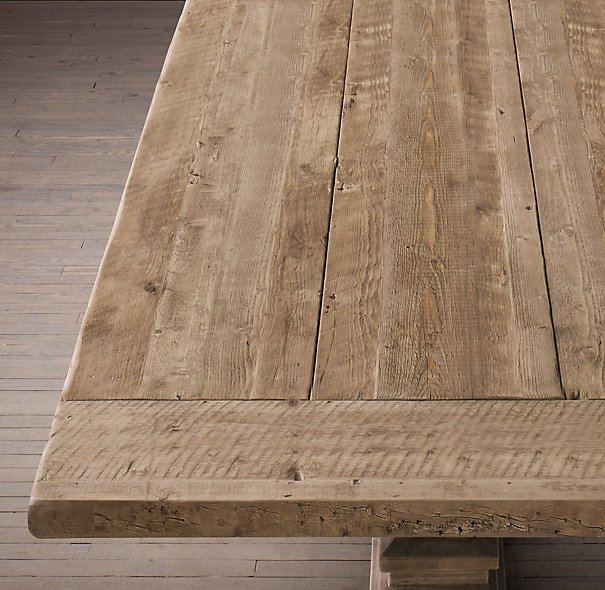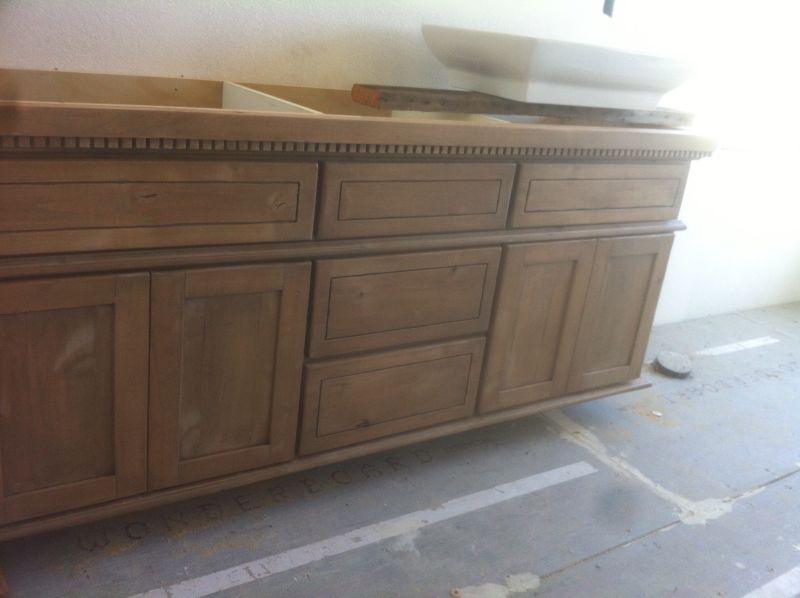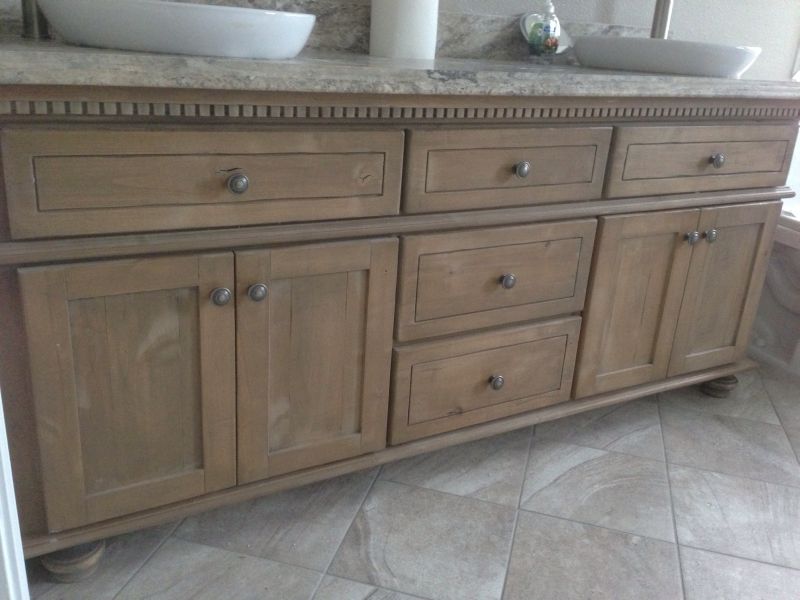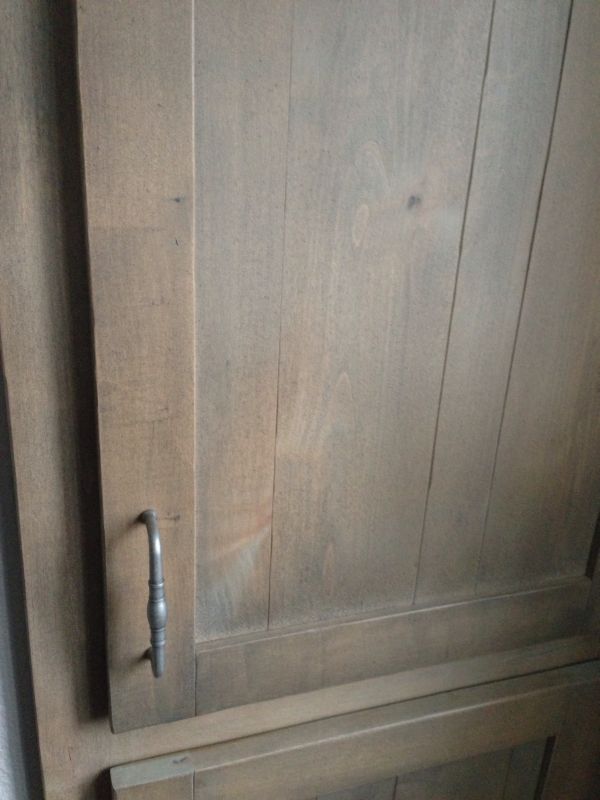Replicating the Look of Salvaged Wood
Finishers consider the problem of how to make fresh lumber look like boards sawn from 100-year-old salvaged timbers. December 23, 2014
Question (WOODWEB Member) :
I have been working with wood all my life and always strive for nice finishes. Right now I am trying to find stain or finish for this restoration hardware table. I canít figure out how they did this stain. I have tried everything - oil stains, latex stains and now a mix of using vinegar and steel wool mixed with brown latex. I had to take the old finish off because it was damaged and now I have to make it look old again.

Click here for higher quality, full size image
Forum Responses
(Finishing Forum)
From contributor T:
Try a two part wood bleach first. It has to be a two part bleach. Then try the steel wool and vinegar if necessary.
From contributor K:
I believe you answered your own question with the title. You say you canít figure out how they did the stain, yet the post is titled salvaged wood. The best I can tell from the photo, that looks to be just naturally aged wood. No stain involved. It can be tough, very tough sometimes, to match a naturally aged wood. In my experience, the color isnít so much the problem as the look that knots and grain acquire over time. They seem to shimmer whereas the stain just blocks them out and fills them with color. In your case I would try the method you are using with the steel wool and vinegar, but would add in some tea. Try a couple different processes. Stain with tea first (this adds tanins) then steel wool and vinegar diluted with water at different ratios. Maybe you will have to add some of the tea directly to the vinegar/wool solution. Itís going to take a lot of experimenting.
From contributor N:
You have your work cut out for you! Before I tell you how I'd go about it, allow me to add my disclaimer. Even though I've been finishing wood for close to 40 years I've only more recently delved into the complex and often frustrating world of furniture decorating. So hopefully (for your sake) someone else with more experience will chime in here too.
If this table came into my shop I'd do as Contributor T suggests and first bleach the table with a two component wood bleach (I've always used Daly's because it's available where I live and the stuff works great). I'd do the same with some fairly large scrap pieces of the same kind of wood as well so you can test on them as opposed to the table.
Then I'd thin down (way down?) some pigmented white oil stain and add a bit of raw umber/van dyke brown to it. It will take some time to get the stain/thinner/umber ratios where you want them. Then I'd spray very light even coats on the table until I got the color where I wanted it. Let it dry until paint thinner will no longer remove stain (24-36 hours).
If you plan on adding a clear finish to the table you could now seal it and then glaze the table with some very thin Van Dyke brown glaze. You'll have to wipe off and probably dry brush feather the glaze so it will hang up in the rough grain, nail/worm holes and recessed saw-cuts. I'd probably spray on the glaze but brushing would work too. In your picture it appears as though they applied the high light color on only some areas of the wood. Now if youíre not applying a clear over the top you'll need to make your glaze with something with some drying oil in it so it won't rub off. Pigmented oil stain should work.
From contributor B:
The wood to me looks a lot like rough sawn/cut butternut which is easy to distress and work with and which you could then seal with just about any clear water white finish. Otherwise you'll have to start with a lighter colored wood and work up a stain or go the bleaching game which is a whole lot of fun.
From contributor D:
I recently built a custom vanity that was inspired out of a restoration hardware catalog as well. We started with s2s alder from my typical dealer. We have an old worn out blade that gave us the saw marks and a hand held belt sander with a bump taped to the backside of the belt to make it bounce and distress. Next we take brown and black lacquer based paints from Home Depot and mix it 1:5 ratio in lacquer thinner and brush it on saturating the wood. We sometimes lightly mist the prices with the paint to darken certain areas and will take white to give it an old worn out paint job look. Next we lightly sand we a DA to bring out the textures. Lastly one or two coats of flat lacquer rubbed out. Not exactly the same finish as your picture but some tweaking and you could replicate it.

Click here for higher quality, full size image

Click here for higher quality, full size image

Click here for higher quality, full size image
From contributor M:
"Our salvaged trestle wood tables are handcrafted of unfinished, solid reclaimed pine timbers from 100-year-old buildings in Europe." These are unfinished tables according to their web site. I have had good luck using ferrous sulfate thinned down and sprayed on oak to duplicate the weathered look, for pine though you will need a coat of tannic acid to make it work properly. A lot of people who duplicate antiques bury the wood in horse manure for a couple weeks to age it, not sure if you want to do that to your table!



